Today the Goonhammer Historicals team continues our ongoing focus on the American Civil War, this time talking about using the Sharp Practice 2 ruleset to game out the innumerable smaller raids and skirmishes that took place during the conflict. Muggins is going to lead us off by talking about possible narratives, location and terrain considerations, and some general observations about using the ruleset for this conflict. Marc “Ilor” Renouf follows this up with some thoughts about using cavalry effectively and offering a house rule for an aspect of the conflict that is not represented in Sharp Practice itself – troops going prone under fire.
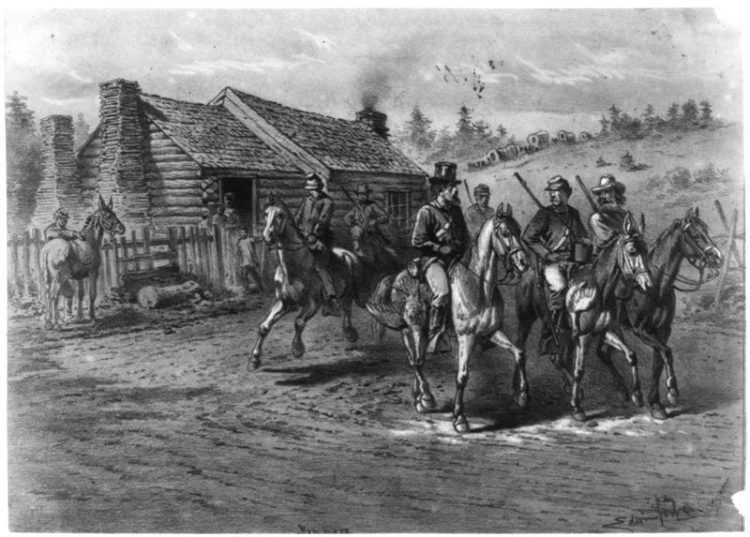
When many wargamers think of Sharp Practice (read our review here), a large skirmish ruleset written by TooFatLardies, they immediately think of Richard Sharpe (with a runner up being Flashman, though I think like many Americans I’ve never grew up reading his escapades), the greatest soldier who ever lived. He mostly fought in the Napoleonic Wars and that is easily the most popular period for the game, based on the authors’ anecdotal evidence from social media. Other very popular periods are the French and Indian War and the Revolutionary War, as they included quite a bit of skirmish or guerrilla type warfare and smaller battles with fewer troops.
Gamers looking for a compelling ACW rule set that also requires many fewer models than some of the traditional corps/division level games (where you might use hundreds or thousands of minis) should look no further than Sharp Practice. The ACW took place nearish the end of the traditional black powder period but the rules work perfect for it. In this article we’ll offer some suggestions of how to get started.
Skirmish vs Battle
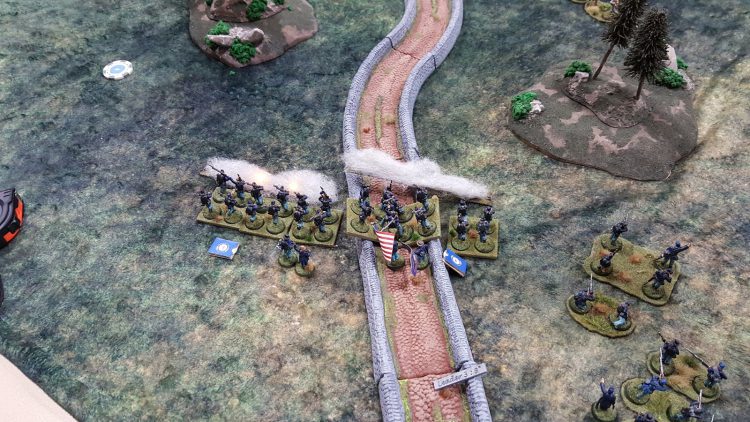
For decades, the traditional mindset of ACW wargamers was focused on refighting the huge battles – the second day at Gettysburg, the Confederate surprise attack at Shiloh, Antietam, etc. While there is definitely merit to this type of gaming, it is very hard for a beginner to get into quickly (unless you’re grabbing that new Epic Battles set from Warlord Games – more on that in a later article!). Sharp Practice allows us to fight smaller engagements with fewer troops and get started faster. This isn’t to say that is the only redeeming quality – far from it – Sharp Practice is a compelling ruleset with a ton of strategy and storytelling angles.
In the past when I’ve run participation games of ACW Sharp Practice at conventions I’ve definitely had grogs rock up and ask what the game is, why there are so few troops on the board, and how many guys each soldier represents. I explain that each guy represents one soldier for my games, and that we’re fighting a large skirmish action. Some just don’t get it, which is fine. But there are plenty of first person accounts of raids, foraging encounters, scouting missions, and we have the Sharpe movies to inspire fictional fights. Of particular note: The Combahee Ferry Raid, The Sinking of the CSS Albermarle, Grierson’s Raid, the St. Albans (Vermont) Raid, and other raid operations during the war. Many of these were cavalry raids, but often times they included infantry or dismounted cavalry.
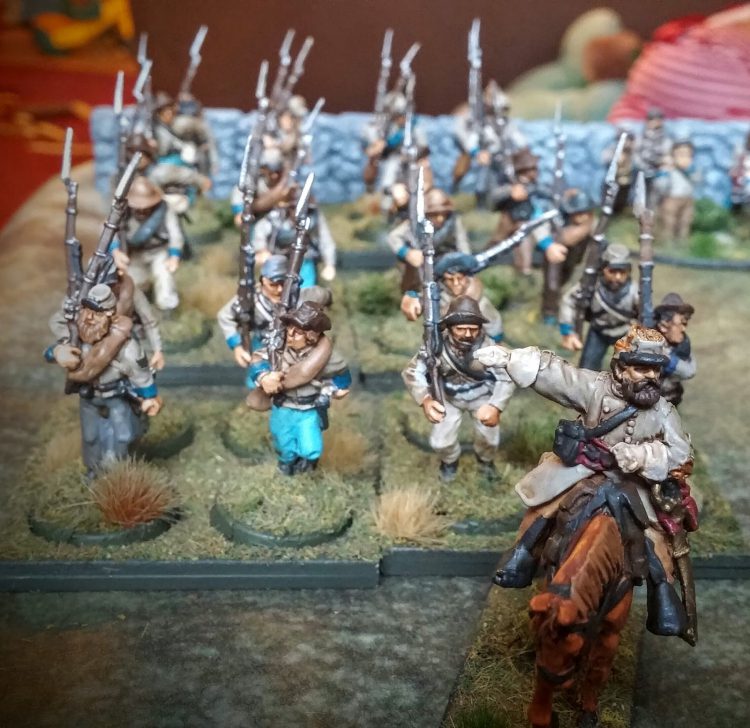
The Narrative
Sharp Practice is very much a story-driven game, and ACW games will definitely benefit from an intriguing story and may be easier to run using made-up elements like people, units, and even places. This frees you from having to make sure everything is entirely correct and allows for some creativity. Some plot hooks that we’ve used in the past or are considering for the future:
- One side is transporting an experimental weapon that needs to be captured or destroyed. The side that is attacking may not know that the weapon is actually operational and ready for use. Experimental weapons I’ve considered: the Williams Gun, the Gatling Gun, and the Agar Gun.
- A spy (perhaps a Pinkerton agent for the Federals, or a southern lady working contacts in the north) is on their way back to friendly lines with very useful information and must be stopped / captured / escorted.
- Confederate civilians are smuggling weapons and other goods through the local area that has been occupied by Federal troops for a while. They’re using coffins or haystacks to hide the materiel and Federal troops will have to risk losing face or angering the locals if they search without smoothing it over first.
- Confederate forces are finally on the verge of launching their new ironclad warship (or submarine!) that could change the course of the war. A small contingent of troops has been sent behind enemy lines to destroy the ship and keep the war from dragging on.
- Federal forces have been tasked with burning a plantation house belonging to a major Confederate sympathizer in the area who has been supplying guerrillas and militia with food and supplies for months. Along the way they may meet enslaved people who need to be freed and militia led by the rich plantation owner.
- A large regional bank in a small town has been targeted for a robbery – by either side. Perhaps Federal forces are attempting to remove the ability of the Confederate government to pay their troops, or Confederates are attempting to capture more gold to further their efforts.
- A minor politician has been captured by enemy forces and is being held as a traitor (or perhaps a foreign official, such as a British emissary). They must be rescued before it gets out in the newspapers and hampers the war effort
- Forces have been tasked with raiding behind enemy lines and destroying railroads, telegraph lines, crops, etc. Often times the first person accounts talk about how both sides would dress as the other to infiltrate and make it past pickets, which could be used as an interesting hook.
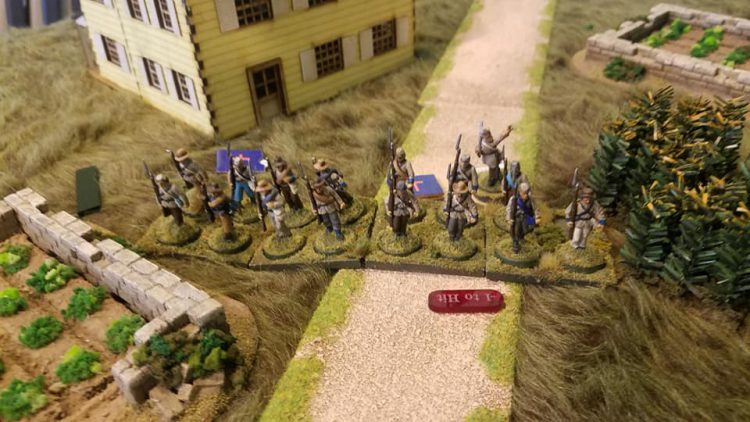
The Location
As a corollary to the narrative aspects, the location in which the fight is taking place can have a strong effect on both the aesthetics of the experience as well as the potential challenges the players might face. Some locations to consider:
- Some areas of the South were very wary of secession and as the war ground on became Unionist sympathizing locations. Of particular note would be Kentucky, Tennessee, Georgia, and North Carolina. It makes for an interesting setting because the Federal player may be able to turn the local populace to their side, or may cause them to go the other way if they’re too violent / oppressive.
- Federally occupied areas such as the coastal Carolinas, Florida, Tennessee, etc make easy locations for militia fights and guerilla actions. There are tons of first person accounts out there as well to help build a story.
- The very far west makes a compelling case because there just hasn’t been a ton of gaming done there. Forces were naturally very small out there and raiding actions would be commonplace.
- In some areas the terrain was very difficult, either due to the roughness of the geographical features (e.g. the hills of the Shenandoah, Tennessee, or northern Georgia) or due to the presence of swamps (lots of places along the Mississippi and Tennessee rivers and their tributaries). Rough or forbidding terrain is perfect for small actions because small units can move and maneuver through areas that would be impassable to large units and their supply wagons.
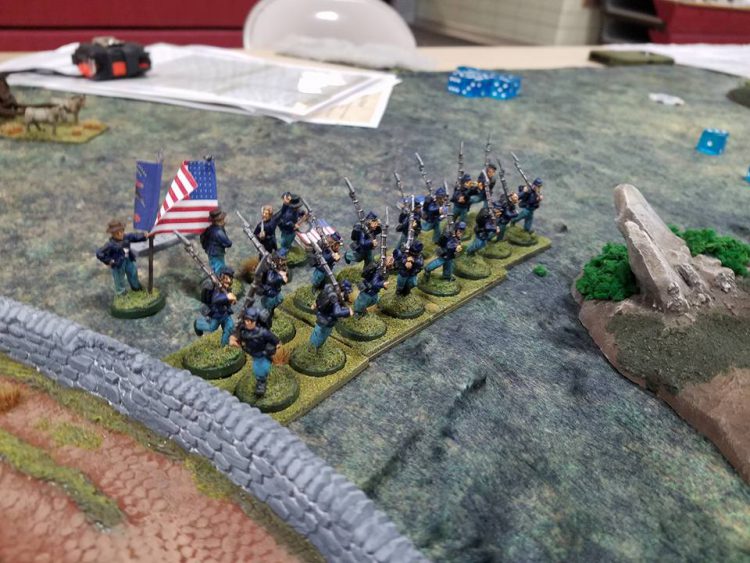
Things to Consider
A few issues have come up as I’ve started playing SP with my ACW troops:
- Models should be based individually. This allows casualty removal. It could be jury-rigged to show dead guys with markers or something, but it just doesn’t work as well in my opinion. Sabot movement trays (usually rectangles with holes for each model) work really well. Be careful to make sure they’re a bit closer than some other games, as you want your guys to look ranked up.
- Be careful using smoothbore muskets in this period. Rifled muskets outrange them by 24″ and muskets do not have an Effective range band. If one side or formation has smoothbores they’re going to be very outmatched in firefights and will have to be much larger in order to close on the enemy. That said, if a unit armed with smoothbore muskets has the “Buck and Ball” characteristic, at close range these units can be lethal. Keep this in mind when setting up your table, as these units will benefit from covered approaches that allow them to close with the enemy without getting shot to pieces on the way in.
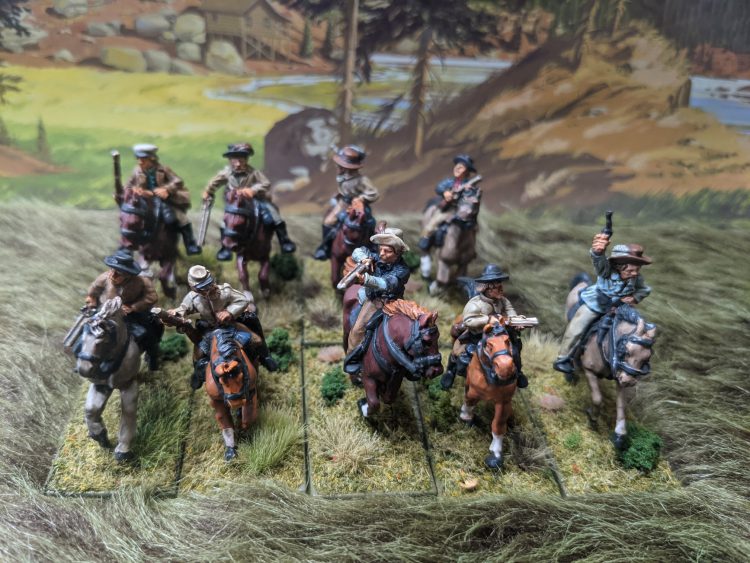
Using Cavalry in SP
Because Sharp Practice is meant to cover the entire black powder era, it includes rules for Cuirassiers and Lancers and the kinds of “impact cavalry” more common in the earlier Napoleonic wars. But by the American Civil War and the broad adoption of the rifled musket, the engagement ranges had opened up to a distance where by the time a cavalry charge got to its destination, it was likely to have been cut to ribbons by repeated volleys of musket fire. That’s not to say that cavalry charges never happened in the ACW – the most certainly did – but they tended to be very limited affairs that took place in very small engagements, and were often the result of a surprise.
As a result, cavalry in the ACW increasingly took on very different roles on the battlefield. When employed in large numbers, most cavalry actually fought dismounted, essentially classed as “dragoons” in Sharp Practice terminology. Dragoons are handled quite well in SP2, giving players a choice – field a dismounted unit of 8 figures that cannot remount, of field a mounted unit of 8 figures that dismounts to a group of 6 (with 2 men left behind as horse-holders), but which can remount if needed. If defending a fixed position, the dismounted group of 8 is preferable, but if you find yourself on the offensive I would recommend keeping your cavalry mounted.
The key temptation to avoid when fielding mounted cavalry, however, is the siren song of the cavalry charge. Cavalry in SP2 tends to be pretty fragile, and its wider frontage often means that a single 8-man group of mounted cavalry is going to end up charging two (or more!) groups of infantry if and when you get into fisticuffs. Because of the vagaries of how combat scores are calculated in SP2, this can often result in cavalry getting massacred in a charge, and even if they manage to inflict more casualties and “win” the encounter, they are often crippled in the process. While many people point to this as a “problem” with mounted melee units in SP2, it’s actually pretty spot on for the period.
If you are planning to charge something with your cavalry, your best bet is not your opponent’s line, but rather his flanking units like skirmishers, units which are almost always single groups and which are already at a disadvantage in close combat. Because skirmishers have the opportunity to “evade” a charge, the extra movement distance afforded to cavalry means that evasion movement is less likely to be enough to avoid contact, which in turn means that any Shock inflicted will be doubled. Cavalry are really good at clearing out annoying skirmishers, which again is historically accurate.
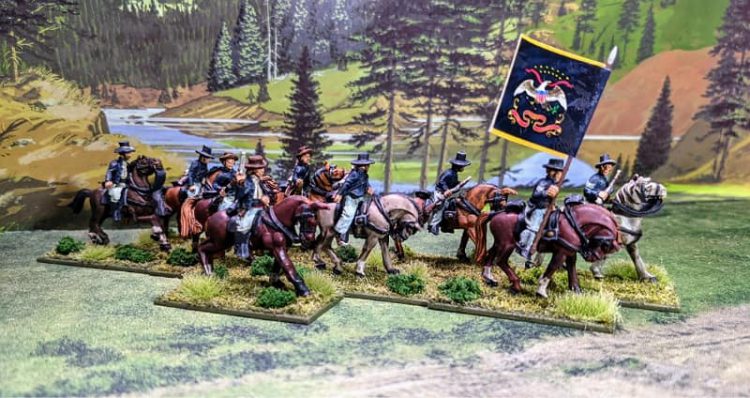
But a far better use for cavalry may simply be to get a unit into position to take flank or rear shots on enemy units. This is best accomplished by moving hard and fast along a flank to get into position before dismounting and applying volleys at your opponent from an inconvenient direction. In the early war, some cavalry (especially Confederate cavalry) has “mixed weapons” which halves their firing at range – but flank shots double Shock, so this helps offset their decreased firepower. And later in the war, when cavalry forces may be carrying repeating rifles, dismounted cavalry dishing out rapid-fire volleys into an enemy flank can be devastating.
Also, don’t forget the effects of the “Moveable Deployment Point” that scouting cavalry offer. Depending on the terrain, you may very well be able to use this capability to partially envelope your enemy when deploying your units. Just be aware that the Movable Deployment Point can only change positions when your primary force leader’s card is drawn, so there’s no guarantee that you’ll be able to move it at the most opportune times. It also requires you to hold your cavalry’s deployment, so you’ll have to weigh the benefits of having them on the field versus widening your deployment options.
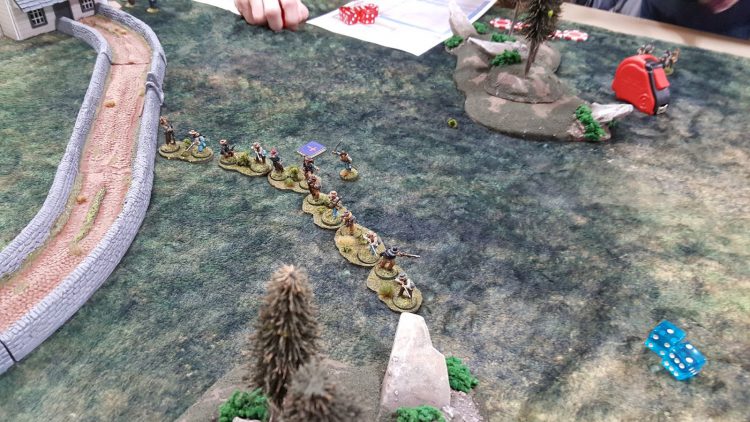
A Useful House Rule
One facet of the American Civil War that is not present in prior conflicts of the black powder era is the idea of entire massed units of men going prone in combat, and sadly Sharp Practice 2 does not address this at all. Given how common it is in the period accounts, it seems like it’s something that should be a part of the game, and thus to handle it we’ve come up with an easy house rule to represent troops going prone in the face of enemy fire.
Prone:
- Dropping prone from standing or rising to standing from a prone position costs one die of movement.
- Units may not move while prone
- A prone unit counts its level of cover as one category better than normal.
- Units that are prone do not block line of sight, nor do they offer screening cover to troops behind them.
- Any unit targeted by fire passing over a prone unit shares hits with that prone unit regardless of the distance between them.
- Prone units require an extra action to reload.
- Prone units which are engaged in fisticuffs always count as receiving a charge unloaded
- Dropping prone breaks a Formation



